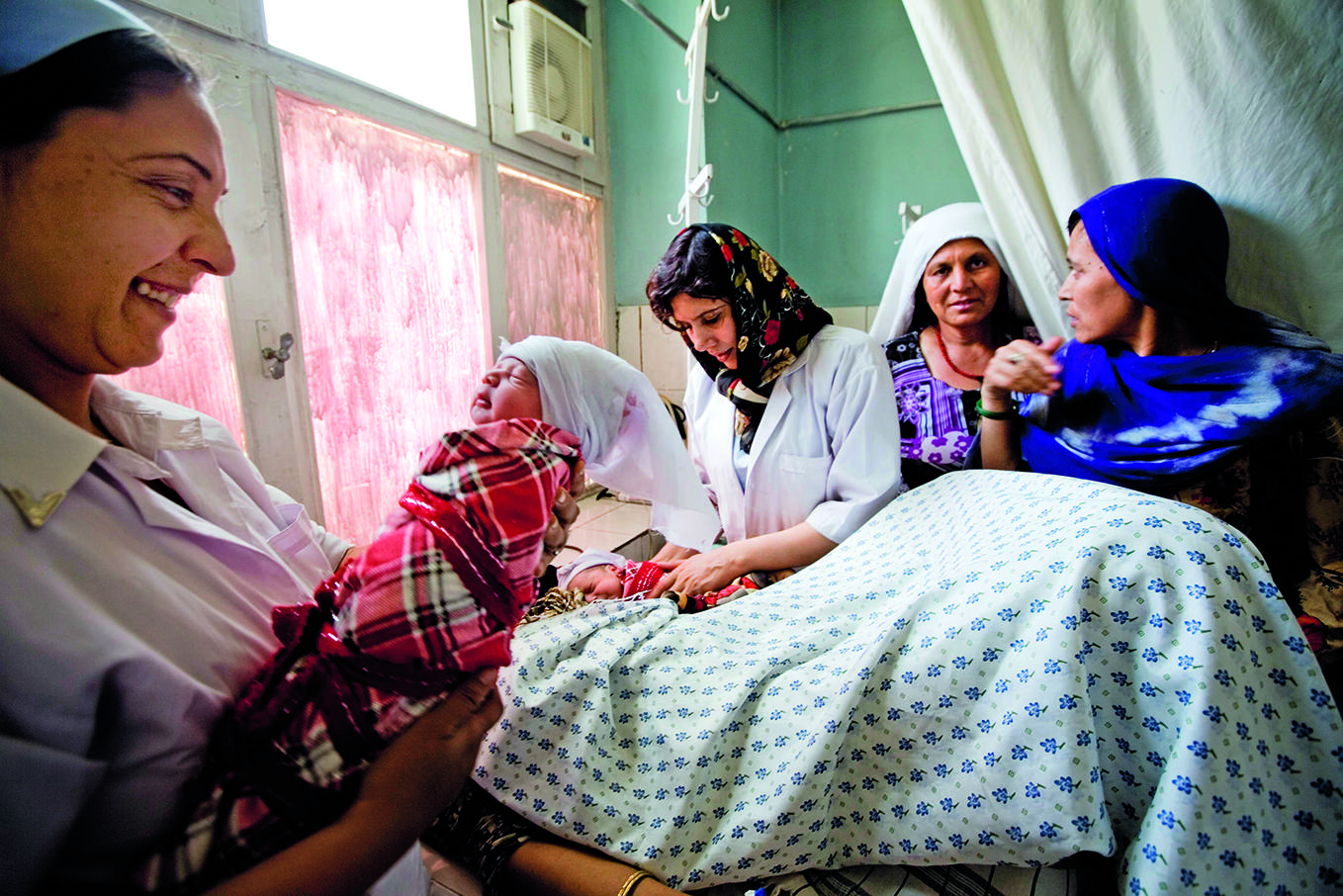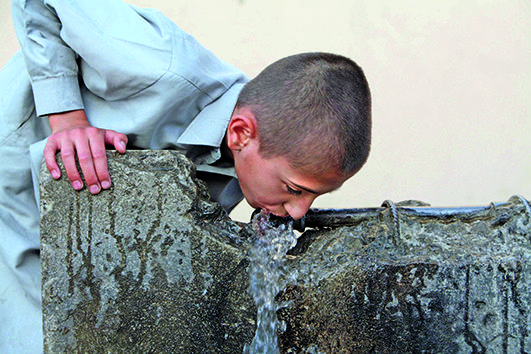A community midwife holds up one of a pair of twins next to its mother in a health centre outside Jawjzan, in Afghanistan – one of 73 countries where more midwives are needed to reduce the high toll of newborn and maternal deaths, according to State of the world’s midwifery 2014. The report was launched last month.
Cuts in carbon emissions aim to improve health
United States power plants – the main source of carbon pollution in the world’s largest economy – must cut these emissions by 30% by 2030, according to new regulations announced by the US Environmental Protection Agency (EPA) last month.
A day later, a government adviser said China would also limit carbon dioxide emissions for the first time. He Jiankun, chairman of China's Advisory Committee on Climate Change, told a 3 June conference in Beijing that an absolute cap on these emissions would be introduced in the next five-year plan.
The developments in China and the United States raised hopes that countries will reach a strong universal agreement at the United Nations Conference on Climate in Paris in December 2015.
The new EPA rules are part of the Climate Action Plan launched last year by US President Barack Obama, who has emphasized the health gains as well as the climate benefits of tackling climate pollution as envisaged by the plan.
After a recent visit to the Children’s National Medical Centre, where the president met a group of children with asthma, he noted the link between air pollution and respiratory diseases. “There are also health effects of climate change that we have to attend to,” Obama said, after the meeting that was captured in a White House video.
According to the EPA, the carbon dioxide cuts will prevent up to 150 000 asthma attacks in children, up to 6600 premature deaths and up to 490 000 missed work or school days, as well as bringing up to US$ 93 billion in climate and public health benefits. There is a 120-day consultation period for any amendments to the rules, after which they will come into effect.
Climate change and health are on the agenda next month when WHO hosts the first major international conference devoted to the subject 27–29 August in Geneva.
WHO calls on countries to raise tobacco taxes
The World Health Organization (WHO) called on governments to make “significant tobacco tax increases” a public health policy of central importance. The call to action is part of a new WHO campaign that was launched on World No Tobacco Day on 31 May.
WHO released a campaign brochure explaining how countries can take simple measures to reduce tobacco use, giving examples of countries that have done this, including Egypt, France, the Philippines and Turkey.
“Raising taxes on tobacco is the most cost–effective solution for reducing tobacco use in all types of settings,” said Dr Douglas Bettcher, director of the Department of Prevention of Noncommunicable Diseases. On average, raising tobacco taxes to increase prices by 10% is estimated to reduce tobacco use by 4% in high-income countries and by around 5% in low- and middle-income countries.
“Tax increases usually bring the biggest health benefit to people with the least amount of money, including young people,” Bettcher said, citing a 2010 study in 20 lower-middle income countries, that a price increase of 10% reduced consumption in adolescents by 18%, more than three times higher than the consumption reduction achieved by the same measure among adults.
Read the brochure Raising tobacco taxes – what do you need to know here: http://www.who.int/campaigns/no-tobacco-day/2014/brochure
This month’s cover shows a boy drinking from a communal tap in Western Kabul, Afghanistan. WHO and the United Nations Children’s Fund released a progress report in May on access to drinking water and sanitation. It found that almost two billion people globally have gained access to improved sanitation, and 2.3 billion have gained access to drinking water from improved sources since 1990. According to the report, entitled Progress on drinking water and sanitation: 2014 update, an estimated 1.6 billion of these people have piped water connections in their homes or compounds.
http://www.who.int/water_sanitation_health/publications/2014/jmp-report
WHO launches childhood obesity commission
WHO Director-General Dr Margaret Chan has launched a high-level Commission on Ending Childhood Obesity to gather the best possible advice to help countries reduce the growing toll of childhood obesity.
Since WHO called the world’s attention to the increasing problems and health consequences of childhood obesity in 1997, many countries have experienced a rapid rise in obesity among infants and children under five years of age. Tackling childhood obesity is an opportunity to reduce heart disease, diabetes and other serious diseases in the future, while improving the health of children.
The Commission has been asked to produce a report specifying approaches and combinations of interventions that would be most effective in different contexts around the world to fight this scourge. It will be delivered in early 2015 so that its recommendations can be presented to the next World Health Assembly.
No single discipline can provide the groundwork for a strategic approach to tackling childhood obesity. Social scientists, public health specialists, clinical scientists and economists will collaborate to compile the best available evidence into a coherent plan.
The commission is co-chaired by Sir Peter David Gluckman, Chief Science Advisor to the Prime Minister of New Zealand, and Dr Sania Nishtar, the founder and president of Heartfile, a nongovernmental organization in Pakistan.
“I am deeply concerned by the increasing prevalence of childhood obesity in every region of the world, with the increase fastest in low- and middle-income countries,” Chan told this year’s World Health Assembly in May. “In the African region alone, the number of overweight children increased from 4 million in 1990 to 10 million in 2012. This is worrisome.”
The World Health Organization has been working on obesity issues (including obesity in childhood and adolescents) ever since it held the first WHO expert meeting on obesity back in 1997.
http://www.who.int/dietphysicalactivity/end-childhood-obesity
WHO and open access
As part of WHO’s reform process, a new policy on open access came into force on 1 July making work by WHO authors, or funded by WHO, that is published in external journals or books, fully accessible to readers free of charge.
In the past, such articles, studies or chapters that appeared in external publications could often only be accessed by readers if they paid a fee. At the same time, copyright agreements with the external publishers imposed restrictions on how these works could be reused.
The information that WHO publishes is freely available on WHO’s website www.who.int. The objective of the new WHO policy on open access is to ensure that articles or chapters published in non-WHO publications that are authored or co-authored by WHO staff or produced by individuals or institutions funded in whole or in part by WHO are now also freely available to the public.
“Knowledge generated with public funds should be accessible to everyone, without any restrictions, and this has been the driver in reforming information sharing at WHO,” said Dr Najeeb Al-Shorbaji, director of WHO’s Knowledge, Ethics and Research department.
From now on, WHO staff and recipients of WHO funding who wish to publish outside the Organization must choose a journal or publication that complies with WHO’s open-access policy. Compliance with this policy means that what is published is subject to a Creative Commons licence that grants the reader the right to reuse all or parts of it without having to seek additional permission, subject to certain conditions including appropriate attribution of the original source.
To allow WHO staff to publish in open access journals, WHO together with other major intergovernmental organizations has negotiated with Creative Commons a special licence appropriate for them (CC 3.0 IGO) http://www.wipo.int/pressroom/en/articles/2013/article_0026.html
The content of the Bulletin of the World Health Organization has always been freely accessible. The approval of the CC 3.0 IGO licence will now allow the Bulletin to implement the use of the Creative Commons licence in the publication of its articles.
All WHO-authored and WHO-funded work produced under the terms of the policy will be deposited in Europe PubMed Central; WHO became a member of this open access repository on 1 May. Such work will also be available in WHO's Institutional Repository for Information Sharing (WHO IRIS).
http://www.who.int/about/policy
New guidelines on cancer registries
The International Agency for Research on Cancer (IARC), WHO and the International Association of Cancer Registries launched new guidelines for establishing cancer registries at the end of May.
The publication, entitled Planning and developing population-based cancer registration in low- and middle-income settings, provides essential guidance on the key steps in planning a registry, including accessing sources of information, monitoring the quality of the data and reporting results.
The guidelines can be used by low- and middle-income countries to achieve a high standard of cancer registration as well as to address the limitations and challenges that these registries may face.
Cancer registries are important for evaluating the impact of national cancer control programmes, including vaccination, screening and treatment efforts and they also serve to catalyse research into causes of the disease.
http://www.iarc.fr/en/media-centre/pr/index.php
28 July – World Hepatitis Day
27–29 August – WHO Conference on Health and Climate, Geneva
23 September – UN Climate Conference at the UN General Assembly, New York

 © Jhpiego/Kate Holt
© Jhpiego/Kate Holt IRIN/Manoocher Deghati
IRIN/Manoocher Deghati